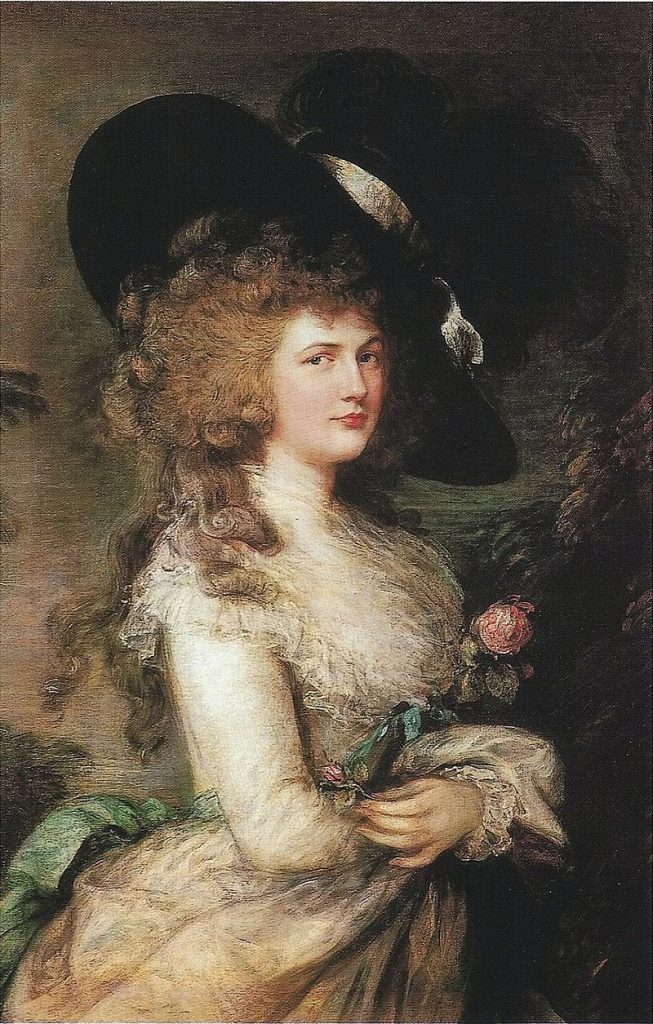“passing the love of woman”, Georgiana Cavendish’s relationships with women
For Pride Month 2020, Rowan Frewin from our Visitor Experience Team has been investigating some of the LGBTQ+ stories associated with Chiswick House. In this article, they discuss their findings on the Duchess Georgiana and the nature of her relationship with Bess Foster.
‘Georgiana Cavendish, Duchess of Devonshire, is best known for her extravagant parties, gambling habit, and being a Georgian fashion icon. She is also well known for the ménage a trois domestic arrangement she inhabited along with her husband, William Cavendish the 5th Duke of Devonshire, and her close friend Elizabeth Foster (hereafter referred to as Bess.) While it is well known that the Duke was in a romantic and sexual relationship with Bess her relationship with Georgiana is less clear and is variously seen as merely platonic, a romantic friendship, or a romantic relationship. Although a lack of concrete evidence means we are only able to speculate about this relationship, the fact that Georgiana had intense relationships with more than one woman suggests that had she had access to our modern terminology Georgiana may have identified as bisexual.

‘Before Bess arrived in Georgiana’s life, there was Mary Graham. Mary, daughter of the 9th Baron Cathcart, is most known for being the sitter in Thomas Gainsborough’s ‘The Honourable Mrs Graham’. Georgiana has been described as the love of Mary’s life, and letters from Georgiana to Mary suggest that these feelings were not unrequited. Georgiana wrote to Mary: “You must know how tenderly I love you… I am falling asleep and must leave you now, but I want to say to you above all that I love you, my dear friend, and kiss you tenderly.” Although the way we use language has changed and 18thc women certainly did speak to each other in a way a modern reader would likely see as romantic, this letter suggests very strong affection between the two women, Amanda Foreman asserts that “Georgiana’s passionate imprecations went far beyond the ordinary endearments written between women friends” (Foreman, 1999, p.69). After Mary’s death of tuberculosis at just 32 Georgiana said of her: “Her goodness, her sense, her sweetness have left a strong impression on my mind; she thought too much of me I am sure; but I have a pride in feeling that she loved me.”
‘Bess entered into the Duchess and Duke’s lives in 1782, and became a central part of their lives. Georgiana and Bess very quickly became incredibly close and soon after their meeting Bess moved in with the couple, an arrangement that lasted almost 25 years. Bess became engaged in an affair with the Duke, one that Georgiana almost certainly knew about, but this did not sour their friendship. In fact, as Lindsey Porter notes, “writers have suggested that the two women had a relationship which was closer than their individual relationship with the Duke.” (Porter, 2016, p.196.) In 1791 Georgiana was banished to France after her affair with Earl Grey resulted in a pregnancy, she was abroad for almost 2 years before she was allowed to return, and instead of staying in England Bess joined Georgiana in France. Once again letters show us the intensity of feelings between them, Georgiana wrote to Bess “My dear Bess, Do you hear the voice of my heart crying to you? Do you feel what it is for me to be separated from you? … Oh Bess, every sensation I feel but heightens my adoration of you.” While after Georgiana’s death Bess described her as “the constant charm of my life. She doubled every joy, lessened every grief. Her society had an attraction I never met with in any other being. Her love for me was really ‘passing the love of woman.”

After Georgiana’s death in 1806 Bess and the Duke’s relationship continued, with Bess becoming Elizabeth Cavendish, Duchess of Devonshire in 1809, however her affection for Georgiana remained evident. Bess wore a locket of Georgiana’s hair until her own death in 1824, as Foreman notes Bess died wearing “A locket carrying one of her friend’s reddish-gold curls, and also a hair bracelet of Georgiana’s” (Foreman, 1998, p.430.) Hair in jewellery served two purposes in this period, either as mourning jewellery or love tokens, whichever purpose this particular locket held indicates that Bess had deep feelings for Georgiana.
‘But how can we speculate about the nature of Geogiana’s relationships with women when we possess no concrete evidence? This is an issue we are often faced with when exploring LGBTQ+ histories, we are rarely presented with neat solid evidence that tells us about the sexuality of a historical figure, instead we must look for clues. Often the issue is that any evidence that did once exist has been destroyed by descendants (often Victorian) who wished to protect the legacy of a relative. This does mean that one way we can look for suggestions of a historical figure’s sexuality is by looking for gaps in evidence. In the case of Georgiana and Bess’ relationship one clue that indicates it was more than just a platonic friendship is the fact that on her death Georgiana left her letters to Bess who subsequently destroyed most of them. Of the letters that weren’t destroyed, many have been heavily redacted during the Victorian period.
‘Although we can never truly say with certainty it seems very likely that Georgiana had romantic relationships with women and that the ménage a trois between The Duchess, Bess and the Duke may have more closely reflected a modern polyamorous triad than a wife reluctantly living with her husband and his mistress.’

Sources:
Foreman, Amanda. (1998), The Duchess. London: Random House Publishing Group.
Porter, Lindsey. (2016), Duchess Georgiana: Georgian Britain’s Most Popular Woman, A New Study. London: Oakamoor Publishing.
https://www.english-heritage.org.uk/learn/histories/lgbtq-history/romantic-female-friendship/
https://www.scotsman.com/arts-and-culture/portrait-lady-2463577